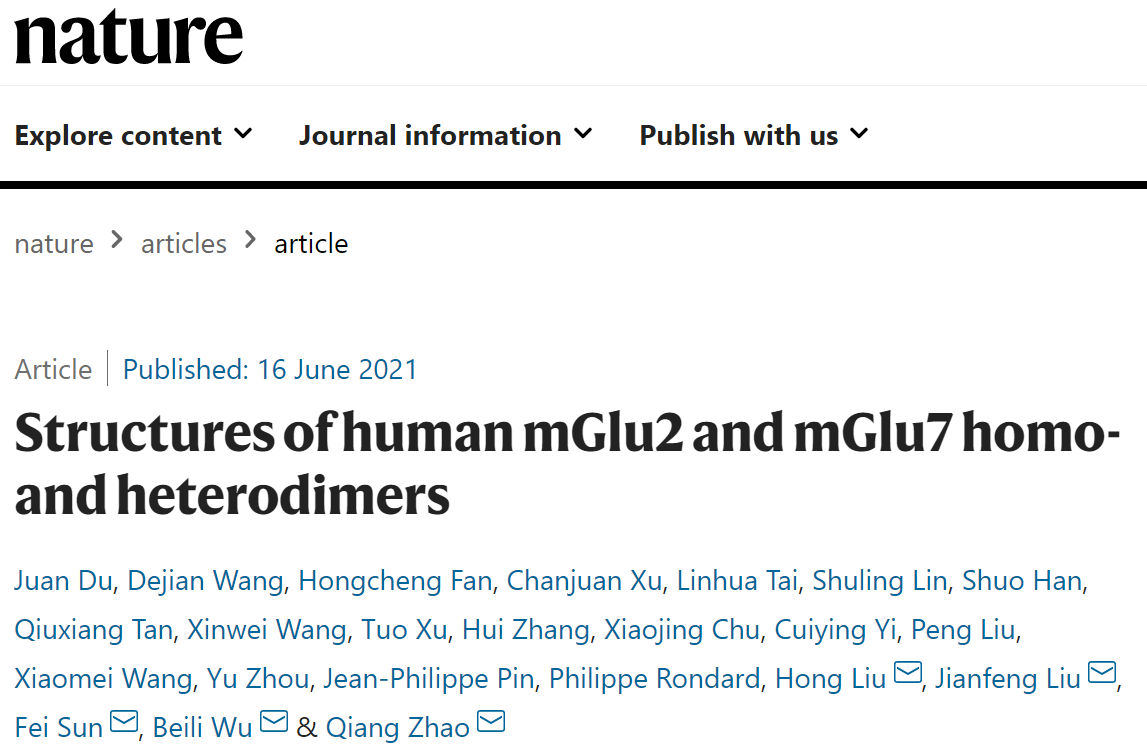On June 16th, the teams of Prof. Jianfeng Liu from College of Life Science & Technology, Huazhong University of Science,key Laboratory of Molecular Biophysics, Ministry of Education , Beili Wu, Qiang Zhao, Hong Liu and Fei Sun of the Institute of Biophysics, Chinese Academy of Sciences published a research article entitled “Structures of human mGlu2 and mGlu7 homo- and heterodimers”in Nature. This study has made a breakthrough in identifying the high-resolution structure and signal regulation mechanism of mGlu2 homodimer, mGlu7 homodimer and mGlu2-mGlu7 heterodimer, which has important guiding significance for the development of specific targeting heterodimer drugs.

Metabotropic glutamate receptors (mGlus) and γ-aminobutyric acid type B receptor (GABAB), which belong to class C G-protein-coupled receptor (GPCR) family, play key roles in modulating neuronal excitability and synaptic transmission in the central nervous system. Eight different mGlus (mGlu1-8) have been identified in humans. These receptors serve as therapeutic targets for a variety of neurological and psychiatric disorders such as Parkinson’s disease, Alzheimer’s disease and schizophrenia, but drugs targeting the mGlus are not currently available. Class C GPCR, such as mGlu and GABAB can form heterodimer, while mGlu can form not only homodimer, but also heterodimerhas long been acknowledged that dimerization is mandatory for the function of the mGlus, a unique behavior different from the other types of GPCRs. There is an increasing amount of evidence suggesting that the mGlus can form both homo- and heterodimers, adding the complexity of functional modulation in this receptor family. However, how these dimers control receptor activity and their recognition by signal transducers (G protein, etc.) remains unclear which limits the development of specific drugs that target it.
Recently, Jianfeng Liu from Huazhong University of Science and Technology (HUST) and scientific groups led by Beil Wu, Qiang Zhao, Mingwei Wang and Hong Liu at Shanghai Institute of Materia Medica (SIMM), Chinese Academy of Sciences (CAS), in collaboration with research groups led by Fei Sun at Institute of Biophysics (IBP) of CAS, have made important progress in class C GPCR studies. Beili Wu, Qiang Zhao, Mingwei Wang, Hong Liu and Fei Sun's group have determined the cryo-electron microscopy (cryo-EM) structures of several mGlus in distinct functional and dimeric states, including inactive mGlu2, mGlu7, mGlu2-mGlu7, and active mGlu2. Jianfeng Liu's group conducted functional studies on the mGlu2-mGlu7 heterodimer, combined with various technical means such as intracellular signal transduction, disulfide bond cross-linking and fluorescence resonance energy transfer experiments, and found that mGlu7 played a leading role in the signal transduction of the heterodimer. The activation differences of mGlu2-mGlu7 heterodimer and mGlu7 homodimer were also explained. These structures, for the first time, provide a full picture of mGlus in different conformational states, uncovering essential molecular details that modulate receptor activation and homo- and heterodimer assembly. The findings highlight the importance of the cooperativity between different subunits as well as between different receptor domains in controlling receptor function, thereby greatly expanding our knowledge about signal transduction of class C GPCRs. At the same time, Professor Jianfeng Liu also participated in another paper of Beili Wu/Qiang Zhao group published back to back in Nature. This work found that the mGlu2 homodimer and mGlu4 homodimer bound G proteins also adopt asymmetric activation patterns. This finding has a similar activation paradigm to the asymmetric activation of G protein by GABAB receptor heterodimer published online in Nature on 18 April by Professor Jianfeng Liu and Yan Zhang, and confirms that GPCR dimer of class C has a unique binding pattern to G protein that is different from other GPCR families. The three papers will be published simultaneously in Nature on June 24.
The first authors of this research paper are Juan Du, a postdoctoral fellow at the Hangzhou Institute for Advanced Study, Chinese Academy of Sciences; Dejian Wang and Shuling Lin, PhD students at the Shanghai Institute of Materia Medica, Chinese Academy of Sciences; Chanjuan Xu, lecturer at Huazhong University of Science and Technology; and Hongcheng Fan and Linhua Tai, PhD students at the Institute of Biophysics, Chinese Academy of Sciences. Jianfeng Liu,College of Life Sciences, and Beili Wu, Qiang Zhao, Hong Liu, Fei Sun, Chinese Academy of Sciences are co-corresponding authors. The main collaborators of this project include Prof. Pin JP and Prof. Rondard P from the Institute of Functional Genetics, France, and Prof. Yu Zhou from the Shanghai Institute of Materia Medica, Chinese Academy of Sciences. The research was supported by the Ministry of Science and Technology, the National Natural Science Foundation of China and the Chinese Academy of Sciences.